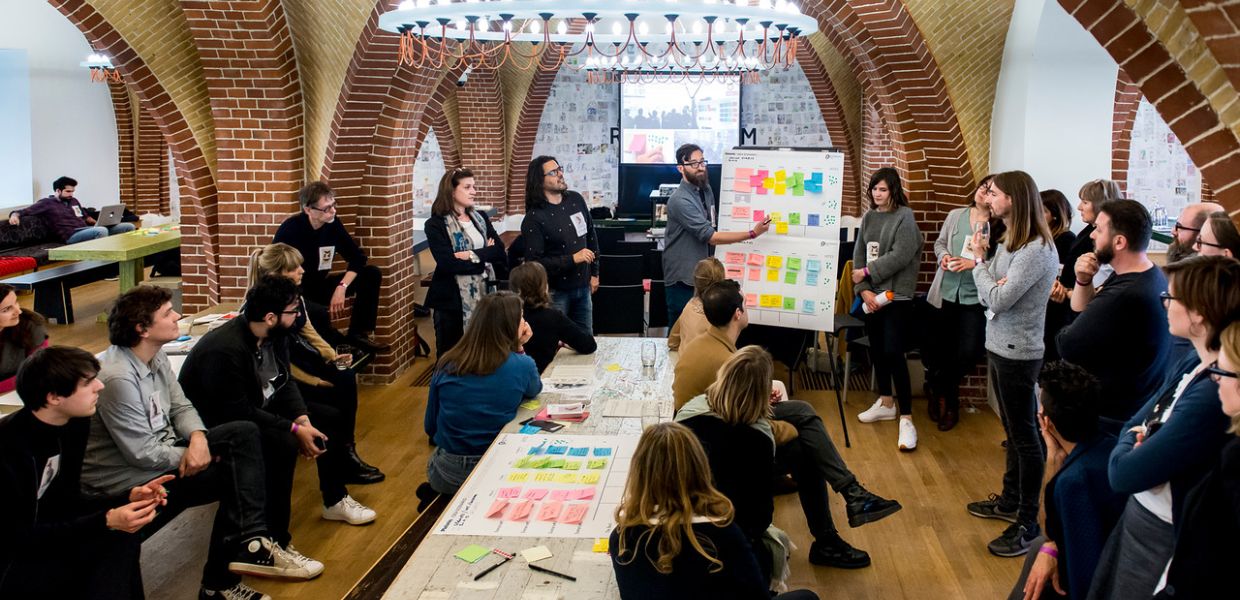Europeana Fashion Co-creation Marathon at Rijksmuseum! 8 hours, 6 prototypes!

This blog post was contributed by Olivier Schulbaum from Platoniq.
On 20 April, Platoniq held a co-creation workshop at the Rijksmuseum in Amsterdam, in collaboration with the Europeana Fashion Association and Europeana. This workshop had a special focus on fashion and on interesting ways to use and re-use digital cultural heritage.
After a welcome greeting from Lizzy Jongma of the Rijksmuseum, Platoniq gave a short presentation explaining the rules of working in open space, and introduced the road map for the upcoming day’s intense activities. Plans for the day included collaboratively designing digital projects and software applications by following the principles of the Co-creation made Agile methodology: starting with idea generation; creating the initial wireframes; and then development planning.

Participants during the Europeana Fashion Co-creation Workshop at the Rijksmuseum.
Which Fashion animal are you?
We got the ball rolling with some lovely antique animal images from Europeana used as symbols for different user roles – a nice introduction to digital heritage reuse. These were prepared as stickers and badges for participants to wear, to help define groups and session roles. The roles and their animal symbols were:
- Content holders / Curators: Kangaroo
- Designers / Creatives: Butterfly
- Developers / Coders: Monkey
- Managers / Promoters: Owl
We had a majority of kangaroos, but they were joined by some butterflies - independent international designers - and a couple of owls, namely people from Benetton, now a supporting member of the Europeana Fashion Association.
Once profiles were chosen, we made groups for the inspiration session, where participants imagine and briefly show something they consider to be good practices (apps, sites, online exhibition, services, etc.) in the digital fashion or digital cultural heritage sector. This helps establish a common criteria, leading to group decision and selection dynamics in the collective prototyping of new ideas.

One of the working groups of the co-creation workshop.
From inspiration we move on to content...new ideas need content! And you’d better start with a reality check: is there content ready to be reused in Europeana, and in participants’ collections?
On one side, with Europeana Fashion we curated a selection of 12 treasures for each of the featured categories: Costumes, Jewelry, Surface Decorations, Shoes, and had it printed. On the other, we asked participants to curate their own boards in advance, revealing 12 treasures of their own collection to be reused.
One of the highlight of the Treasure Hunt exercise was a selection from the Israel Museum, Jerusalem. Curated by Allison Kupietzky, it features elegant and ornate bridal dresses and accessories of diverse origins.
Once we’ve got good scenarios and good content, it’s time for prototyping. Check out the six prototypes created during the workshop:
- Pattern Finder (for Sewing, Knit and Crochet Patterns found in vintage magazines): What if as a needlework, craft or sewing enthusiast, I could search for and download vintage patterns online and experiment with them, making notes and uploading my results so other sewing crafters can get better results.
- Fashion Time Machine: What if as a historical clothing maker, I could find instructions for any element of garments found in historic fashion exhibitions, and use multiple techniques (sewing, needlework, 3D printing) so the entire item could be faithfully reproduced - or even just my favorite parts (e.g. Valentina Project: free software for fashion pattern design).
- Accessory Searches: What if as a fashion or historical costume exhibit curator, I could search for important fashion accessories, and find similar relevant items and their historical reference data, so the collections I make will be beautifully coordinated as well as place and period accurate.
- Europeana Research: What if as a fashion researcher exploring Europeana as a search tool, I could perform very detailed searches and receive excellent results with many related items which could be offloaded (“pinned”) to a personal space, so my searches could be superior in accuracy and conveniently organized.
- Fashion Pockets: What if as a young fashion enthusiast, I could use an intuitive search and organization app using visual “bubbles” to collect and combine multimedia items and share with my friends to build an interesting and inspiring group of collections.
- Spot It: What if as a fashion enthusiast, I can use a smartphone photo to search for similar items in the Europeana database, and see how close I get to my target item, so I can share or save the images on social media.

Professionals of the fashion industry came up with prototypes of products or services that re-use digital cultural heritage.
If you want to see the results of our Fashion Heritage workshop, you'll find all the prototypes on our new Wotify dashboard site. Please give us your feedback, your comments are welcome!
Images by Jan-Kees Steenman.
